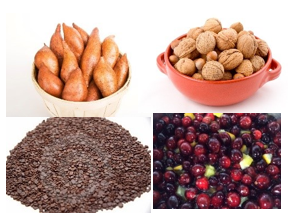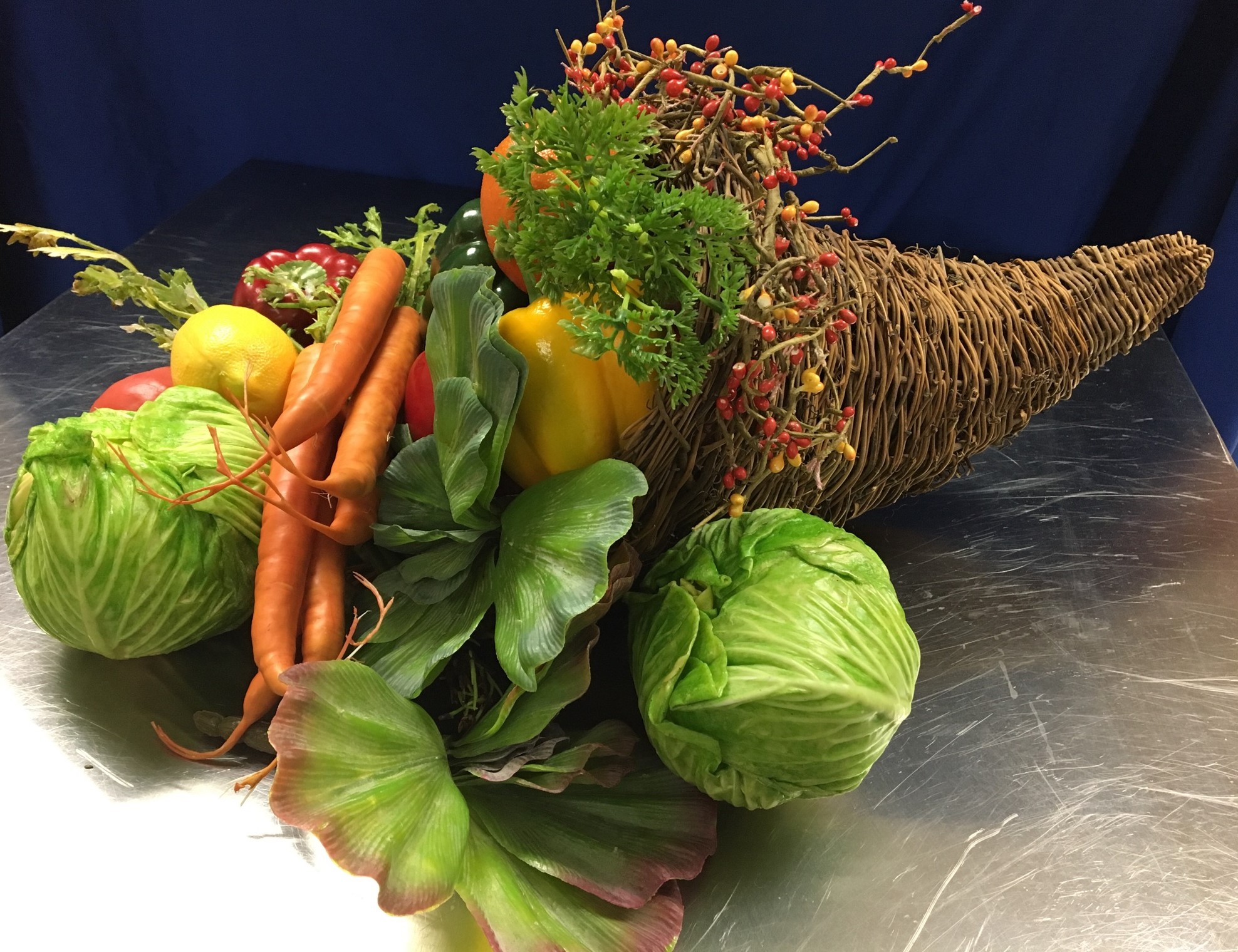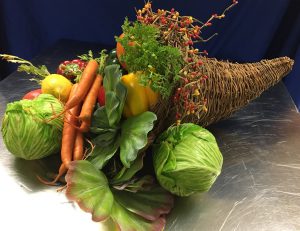by Ginny Hinton | Nov 25, 2016
As we head into the season of overindulgence, it’s good to know that some holiday “treats” can actually be nutritiously guilt-free if we eat them in moderation. Read on to find the hidden health benefits of some classic favorites.
Sweet Potatoes: Sure, it’s a no-brainer that sweet potatoes are a source of vitamins, but these super veggies may be even better for you than you think! Your body converts the alpha and beta carotene from sweet potatoes into Vitamin A, helping keep your eyes, bones and immune system in top shape. Choose firm sweet potatoes with tapered ends and a uniform shape and color.
 Nuts: Even though nuts are high in calories and fat, they are loaded with vitamins and minerals. The fat in nuts is heart-healthy. In fact, research suggests that eating just a handful of nuts a few times a week may lower heart disease risk. Nuts are also a great source of antioxidants, energy and protein. You might consider nuts a Christmas gift to your body!
Nuts: Even though nuts are high in calories and fat, they are loaded with vitamins and minerals. The fat in nuts is heart-healthy. In fact, research suggests that eating just a handful of nuts a few times a week may lower heart disease risk. Nuts are also a great source of antioxidants, energy and protein. You might consider nuts a Christmas gift to your body!
Cocoa: Who doesn’t love a steaming cup of hot cocoa? Now, we know that its health benefits give us even more reason to love it. For example, cocoa contains antioxidants called flavonoids that may lower the risk of heart attack or stroke. Dark chocolate with a high percent of cocoa solids may help lower blood pressure, improve blood vessel health, and regulate cholesterol levels. So, give in to your craving – in moderation, of course!
Cranberries: With their rich red color, cranberries add a festive touch to any holiday table. Beautiful cranberries contain only 45 calories per cup while offering a healthy dose of benefits. They’re a good source of vitamin C and fiber, and they outrank nearly every other fruit and vegetable in the amount of disease fighting antioxidants they contain. Buy cranberries fresh in fall and winter and store them in a tightly sealed bag in your refrigerator to keep them fresh longer.
References:
EatingWell. Surprisingly Healthful Seasonal Treats. http://recipes.millionhearts.hhs.gov/articles/surprisingly-healthful-seasonal-treats
Hendrick, Bill. Cocoa Rich in Health Benefits. WebMD Health News. March 23,2011. http://www.webmd.com/diabetes/news/20110323/cocoa-rich-in-health-benefits
Lerch Davis, Jeanie. Cranberries, Year-round Superfood. Web MD Feature. 9/29/2009. www.webmd.com/food-recipes/features/cranberries-year-round-superfood.
Mayo Clinic Staff. Nuts & your heart: Eating nuts for heart health. 9/15/2016. www.mayoclinic.org.

by Ginny Hinton | Nov 25, 2016
 It’s a fact. We need salt in our diets. Our bodies need sodium, which we usually get through salt, to maintain fluid balance and blood volume. Unfortunately, most of us consume at least twice as much sodium as we need.
It’s a fact. We need salt in our diets. Our bodies need sodium, which we usually get through salt, to maintain fluid balance and blood volume. Unfortunately, most of us consume at least twice as much sodium as we need.
The main culprit for sodium intake is not the salt we sprinkle on food, nor is it the salt we use when we cook. It’s the processed foods we grab to make meal preparation quicker and easier – the breads, soups, pizza, cheese, snacks, and more. For example, most of us require only 1,500 mg of sodium, or ¾ teaspoon, per day. Just one slice of a typical frozen pizza contains more than half that amount.
It’s a good idea to buy fresh, frozen, or low sodium veggies, choose roasted meats over processed lunch meats, and read labels to find low sodium choices when possible. How do you know your item is low sodium? It should contain 140 mg or less of sodium per typical serving. If that’s hard to remember, just look for foods with a Daily Value (DV) of 5% or less.
Soup is one of the worst offenders when it comes to sodium content. Unfortunately, when commercial soups are cooked at a high temperature long enough to kill potentially harmful bacteria, the soups lose some of their flavor. Salt offers a cheap and easy way to make up for that loss. Still, many soups can be a great choice, especially if you’re counting calories. How can you enjoy a quick cup of soup without loading up on the salt? Start with a can of light or reduced sodium soup then add your favorite fresh or unseasoned frozen veggies. You’ll still get more sodium than you would with homemade soup but you’ll get much less than in typical canned soup, with an added nutrient and fiber boost.
With a few changes, you can reduce your sodium and still enjoy tasty meals!
References:
University of Florida IFAS Extension, Keeping the Pressure Down, Lesson 4: DASH Diet – Balancing Minerals.
Dahl W & Foster L. Shopping for Health: Sodium
Nutrition Action, Do You Want to Discover Ways to Cut Salt from Your Diet? 10/17/2016

by Marie Arick | Nov 17, 2016

The holidays are fast approaching! Pause long enough to avoid the pitfalls of overspending. Budgets are always tight during holidays. Gifts are not about the cost, rather they are a display of the true relationship of the people involved.
Gift giving at its finest is a true art form. I have a dear friend who really captures the essence of each person with each gift she gives. Gifting is a statement that demonstrates how important the receiver is and how they are perceived in the giver’s eyes.
Always consider the occasion and the relationship with the receiver. It is also important to know the receiver’s culture as to be certain not to offend. A gift given as an afterthought usually displays just that – it was not originally intended to be given. This is not generally the intention of the giver but can give this impression. Additionally, if you intend to re-gift an item, be certain the item meets the personality of the receiver. Re-gifted items tend to be unusual or offbeat, so think hard before taking this path.
Consider practical, useful gifts that match the person you are shopping for. The idea of gifting a need, a want, a clothing item, and a literature item to a person has been one of the most recent trends. Very few people buy that many gifts for those outside of their immediate family. But, this could be applied to others by just taking one of the options. If they are a reader, consider a gift card to a local bookstore instead of a specific title. This provides the option of an e-book or print version. Or, clothing could come in the form of a nice scarf or other accessory that is a part of their usual style.
A gift is a statement of caring. For each person, this is different. Take the time to consider personality, hobbies, interests, and activities. Choose a gift that matches one or more of these considerations. This lends to the true purpose of gifting – to show the receiver how much they mean to you.

by Amy Mullins, PhD, RDN | Nov 16, 2016
 Ever feel like you’re moving through your work day at the speed of light with barely enough time to eat, much less eat healthy? The combination of stress, poor eating habits, and lack of exercise can lead to becoming overweight and the development of chronic health conditions such as type-2 diabetes, high blood pressure, and cardiovascular disease. Numerous studies have shown that stress can lead to poor nutritional choices including:
Ever feel like you’re moving through your work day at the speed of light with barely enough time to eat, much less eat healthy? The combination of stress, poor eating habits, and lack of exercise can lead to becoming overweight and the development of chronic health conditions such as type-2 diabetes, high blood pressure, and cardiovascular disease. Numerous studies have shown that stress can lead to poor nutritional choices including:
- Choosing a sugary and/or caffeinated drink over water
- Grabbing convenience foods more often, which usually are not healthy choices
- Forgetting meals and making poor choices later in the day, ultimately eating more calories, sugar, fat, and sodium
The fact is we are all busy. But, if we don’t take the time to care for ourselves, we may be headed down a dangerous path of self-destruction. It only takes a small amount of time to take the right steps toward better health.
Here are some tips to get you started:
- Simplify! Instead of being overly concerned with counting calories or measuring portion sizes, think of your diet in terms of color, variety, and freshness.
- Start slow and make changes to your eating habits over time.
- Every change you make to improve your diet matters!
- Think of water and exercise as food groups in your diet.
- Moderation is key. Try not to think of certain foods as “off limits,” but, rather, think smaller portions.
- It’s not just what you eat, it’s how you eat. Mindful eating – listen to your body and take time to enjoy your food and mealtimes.
- Fill up on fruits and vegetables.
- Choose whole grains.
- Focus on healthy fats and limit saturated fats and fried foods.
- Try different types of lean protein.
- Limit sugar and salt.
- Plan Ahead
- Take the time to make a grocery list before going to the grocery store
- Plan and pack nutritious snacks for work
- Prepare meals for the week ahead of time
- Consider your options when eating out
- Portion out meals and snacks ahead of time
- Have water available all day
- Incorporate Exercise into Your Daily Routine
- Choose the stairs over the elevator
- Walk during breaks
- Turn housework into exercise
- Walk the dog
- Park further away when you drive to the store
- Play outside with your kids
Remember, nothing is more important than your health and the health of your family. Set a good example for those you love by taking care of yourself. They will be thankful you made plans to be around for many years to come!
For more information about this topic or other nutrition and wellness-related topics, contact Amy Mullins, MS, RDN at amymullins@ufl.edu.

by sbouie | Nov 16, 2016

Photo credit: www.thailandblog.nl
Maybe you know someone in your family, a friend, or a co-worker that has diabetes. Diabetes affects not only the person but the entire family. This article will discuss the types of diabetes and symptoms. Education concerning diabetes begins at home. Once we are educated, we can teach our family and the younger generation.
Type 1 diabetes is usually diagnosed in children and young adults and was previously known as juvenile diabetes. Only 5% of people with diabetes have this form of the disease. In type 1 diabetes, the body does not produce insulin. The body breaks down the sugars and starches you eat into a simple sugar called glucose, which it uses for energy. Insulin is a hormone that the body needs to get glucose from the bloodstream into the cells of the body.
Type 2 diabetes is the most common form of diabetes. If you have type 2 diabetes, your body does not use insulin properly. This is called insulin resistance. At first, your pancreas makes extra insulin to make up for it. But, over time, it isn’t able to keep up and can’t make enough insulin to keep your blood glucose at normal levels.
Gestational Diabetes – During pregnancy, usually around the 24th week, many women develop gestational diabetes. A diagnosis of gestational diabetes doesn’t mean that you had diabetes before you conceived or that you will have diabetes after giving birth. However, women who’ve had gestational diabetes have a 35 to 60 percent chance of developing type 2 diabetes in the next 10 to 20 years after giving birth.
Some common symptoms of diabetes include urinating often; feeling very thirsty; feeling very hungry – even though you are eating; extreme fatigue; blurry vision; cuts/bruises that are slow to heal; weight loss – even though you are eating more (type 1); tingling; pain; or numbness in the hands/feet (type 2).
Food selection is a key element of living with diabetes. It is easy to find diabetes cookbooks and recipes online to assist in adjusting your diet. It is easy to find a list of starchy vegetables to avoid as well as other foods that should be eliminated from one’s diet.
Exercise also is a very important factor when living with diabetes. A good exercise program along with a proper diet will help decrease your risk of diabetes.
Source: American Diabetes Association

by Heidi Copeland | Nov 16, 2016
 With Thanksgiving around the corner, it is only fitting to display a cornucopia. Not only is this horn of plenty a universal symbol of abundance, it is truly timely! Florida is plentiful with fresh produce this time of year. According to the Florida Department of Agriculture and Consumer Services (FDACS), avocados, bell peppers, carambola, cucumbers, eggplant, grapefruit, guava, mushrooms, oranges, passion fruit, peanuts, radishes, snap beans, squash, strawberries, sweet corn, tangerines, and tomatoes are in season now.
With Thanksgiving around the corner, it is only fitting to display a cornucopia. Not only is this horn of plenty a universal symbol of abundance, it is truly timely! Florida is plentiful with fresh produce this time of year. According to the Florida Department of Agriculture and Consumer Services (FDACS), avocados, bell peppers, carambola, cucumbers, eggplant, grapefruit, guava, mushrooms, oranges, passion fruit, peanuts, radishes, snap beans, squash, strawberries, sweet corn, tangerines, and tomatoes are in season now.
Locally, Red Hills Small Farm Alliance boasts an even greater array of foods grown within our community. Local growers are producing vegetables, as well as fresh herbs, fruits, and nuts! Foods growing in the community include arugula, Asian greens, eggplants, baby Pac Choi, kale, butter lettuce, watercress, elephant garlic, peppers (aji dulce, datil, habanero, banana, and serrano), salad turnips, mustard greens, okra, sweet potatoes, persimmons, Meyer lemons, satsuma/tangerines, ponderosa lemons, and herbs such as African blue basil, apple mint, ginger, oregano, garlic chives, lemon balm mint, and rosemary. Plus, the trees are full and American chestnuts and pecans have started falling in Monticello! It is a great year for local produce!
With the abundance of fresh seasonal produce available locally, it is easy peasy to build a healthy plate. MyPlate, the illustration of the five food groups that are the building blocks for a healthy diet, encourages the consumption of a variety of fruits and vegetables every day. In general, 1 cup of raw or cooked vegetables or vegetable juice or 2 cups of raw leafy greens can be considered as one serving from the Vegetable Group. Any vegetable or 100% vegetable juice counts as a member of the Vegetable Group. Vegetables may be raw or cooked, fresh, frozen, canned, or dried/dehydrated, and may be eaten whole, cut-up, or mashed.
Based on their nutrient content, vegetables are organized into 5 subgroups: dark-green vegetables, starchy vegetables, red and orange vegetables, beans and peas, and other vegetables.
Similarly, fruit is a building block, too. Overall, 1 cup of fruit or 100% fruit juice, or ½ cup of dried fruit can be considered as one serving from the MyPlate Fruit Group.
Plus, ½ ounce of nuts or seeds can be considered as a one ounce-equivalent from the Protein portion of MyPlate.
Alice Henneman, MS RDN, Extension Educator with the University of Nebraska Lincoln, suggests an easy way to incorporate a wide variety of vegetables into a daily diet is by making a casserole from what you have on hand (and even add a few nuts for depth of flavor). Why not delve into the Florida Fresh horn of plenty and whip up something good this month? Don’t forget to eat your fruit for dessert!
“Make-Your-Own” Casserole
Makes 6 servings
General Directions:
Select food(s) from each category or use your own favorites. Combine in a buttered 2 to 2 1/2 quart casserole dish. Cover and bake at 350 F for about 50 minutes to 1 hour or microwave using 50% power for about 15 to 30 minutes, rotating or stirring as necessary. Heat until steaming hot (165 F) throughout.
Starch: select ONE:
- 4 cups noodles or pasta cooked
- 2 cups cooked long-grain white or brown rice (or other grain)
Protein: select ONE:
- 2 cups cooked ground meat
- 2 cups cooked and diced chicken, turkey, ham, beef, or pork
- 2 cups chopped hard-cooked egg
- 2 cups fish or seafood, flaked (you can use canned)
- 2 cups cooked or canned beans (kidney, etc.)
Vegetable: select ONE or add a variety:
- 1 (10-oz.) package thawed and drained frozen spinach, broccoli, green beans, or green peas
- 1 16-oz. can green beans, peas, carrots, or corn
- 2 cups sliced fresh zucchini, bell peppers, mushrooms, snap beans, squash, sweet corn, or tomatoes
Sauce – select ONE:
- 2 cups white sauce or 1 can sauce-type soup (mushroom, celery, cheese, tomato, etc.) mixed with milk to make 2 cups
- 1 16-oz can diced tomatoes with juice
Flavor: select ONE or MORE:
- 1/2 cup chopped celery, 1/4 cup chopped onion, 1/4 cup sliced black olives
- 1 – 2 teaspoons mixed dried leaf herbs (basil, thyme, marjoram, savory)
- Fresh Garlic to taste
- Salt and pepper to taste
Topping – select ONE or MORE:
If desired, after heating, place on top:
- 2 tablespoons grated Parmesan cheese
- 1/4 cup shredded Swiss, Cheddar, or Monterey Jack cheese
- 1/4 cup buttered bread crumbs
- 1/4 to 1/2 cup canned fried onion rings
Return casserole with topping(s), uncovered, to oven for about 10 minutes or to microwave for about 2 minutes.
 Nuts: Even though nuts are high in calories and fat, they are loaded with vitamins and minerals. The fat in nuts is heart-healthy. In fact, research suggests that eating just a handful of nuts a few times a week may lower heart disease risk. Nuts are also a great source of antioxidants, energy and protein. You might consider nuts a Christmas gift to your body!
Nuts: Even though nuts are high in calories and fat, they are loaded with vitamins and minerals. The fat in nuts is heart-healthy. In fact, research suggests that eating just a handful of nuts a few times a week may lower heart disease risk. Nuts are also a great source of antioxidants, energy and protein. You might consider nuts a Christmas gift to your body!








